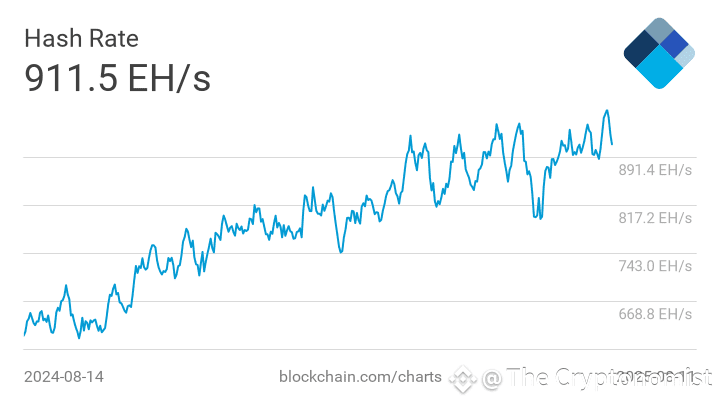
The drop in Bitcoin hashrate surprised many within the community, especially after a long period in which computing power reached record levels, exceeding 750 exahash per second (EH/s).
This contraction of computing power coincides with a significant increase in mining difficulty, which for the first time has surpassed the historical threshold of 100 trillion units (100T). According to data collected by various industry operators, this peak in difficulty represents a turning point in the operational efficiency of mining farms.
This is a fundamental parameter that determines who can rely on effective competition in the network. Let’s see what the factors behind this change are and why it is arousing interest even among professional miners worldwide.
Mining difficulty and Hashrate: a balance under pressure
The hashrate Bitcoin represents the total computing power used to ensure the security and integrity of the protocol. The mining difficulty adjusts automatically, typically every two weeks (approximately every 2016 blocks), in order to keep the average time between blocks stable at 10 minutes.
 The hashrate of the Bitcoin network experiences a sharp drop after a long period of ascent. Source: Blockchain.com
The hashrate of the Bitcoin network experiences a sharp drop after a long period of ascent. Source: Blockchain.com
When the hashrate increases, the difficulty rises accordingly, making block resolution more challenging. Conversely, a drop in hashrate leads to a reduction in difficulty, which acts as a stabilizing mechanism for the network, protecting it from sudden misalignments.
Authoritative sources such as the Bitcoin Mining Council and blockchain.com data highlight how these adjustments are essential to keep the system fair, preventing manipulations and excessive concentrations of computing power only among technologically advanced operators. Industry analysts observe that these automatic mechanisms represent a key point in the security and adaptability of the Bitcoin network.
The true causes behind the fluctuations of the Hashrate
Variable energy costs: in 2024, there were significant fluctuations in electricity prices in key areas for mining, such as North America and Eurasia, directly affecting the profitability of mining farms.
Regulatory changes: government interventions or scheduled blackouts, like the one that previously affected China, now marginal in global mining, can quickly redefine the distribution of hashrate on a global scale.
Hardware updates: the entry of more efficient ASICs pushes operators with obsolete devices out of the market, thus optimizing global power.
Market dynamics: the price trend of Bitcoin, fluctuating between 27,000 and 35,000 dollars in the first months of 2024, significantly influences the profitability of mining activities.
Overall, these components confirm that the observed fluctuations are physiological. For many experts, they indicate adaptation phases that favor a more resilient and sustainable network in the long term, as confirmed by periodic analyses from CoinShares.
How is the mining Difficulty modified?
The difficulty is updated regularly to maintain the average extraction time of 10 minutes per block. The most recent data, provided by platforms like Mempool and CoinWarz, show how the difficulty has reached historic peaks. Studies highlight that such adjustments are crucial to ensure the robustness and security of the Bitcoin blockchain over time.
Mining difficulty on the rise: the effects on miners and computing power
Each increase in mining difficulty tends to challenge less efficient miners, often forcing them to temporarily suspend or shut down operations due to reduced profitability. The consequences are:
Strengthening of the status quo of the network: competition rewards those with modern technologies and solid operational capabilities, contributing to a more secure network.
Increase in the security of the blockchain: the computing power tends to stabilize at high levels, defending the network from potential attacks, such as the 51% one.
Temporary slowdowns: in cases of rapid drops in hashrate, the block extraction speed can slow down until the difficulty adjusts downward.
These developments are closely followed by market analysts and the international specialized press, with constantly updated data
Historical Overview: Unstoppable Growth or Warning Signs?
The hashrate of Bitcoin has maintained a steady growth in recent years, supported by the expansion of facilities in regions with low energy costs such as the USA, Kazakhstan, and Canada, and by increasing infrastructural investments. However, bear phases like the current one, even if temporary, represent a challenge especially for miners with reduced margins and can influence the global distribution of computing power.
Hashrate and security: the indispensable link for the blockchain
A high computing power is essential to make the Bitcoin network practically unassailable, significantly reducing the risk of double spending and ensuring the integrity of transactions. Decentralization continues to represent an indispensable pillar for the security of the protocol, as highlighted by the Bitcoin Foundation and numerous cybersecurity experts.
Fluctuating Hashrate: Opportunity or Threat for the Blockchain?
An increasing hashrate is often interpreted as a signal of confidence in the protocol. However, significant fluctuations reflect technological adjustments and new market setups. The exit of small operators from the sector can, on one hand, strengthen the network’s resilience, but on the other hand, it raises discussions about the possible concentration of computing power in the hands of a few large players, an aspect closely watched by industry insiders and reported by various sector analyses.
FAQ – Everything You Need to Know About Bitcoin’s Hashrate Today
What is meant by block extraction rate?
The block extraction rate refers to the frequency with which new blocks are added to the blockchain, on average every ten minutes. This value remains relatively constant thanks to the automatic adjustment mechanism of mining difficulty.
Does the Hashrate recover after the declines? When and why?
According to the Cambridge Centre for Alternative Finance Annual Report, 2024, every time mining costs decrease – for example, thanks to technological innovations, reductions in difficulty, or energy consumption incentives – the hashrate tends to recover rapidly. This recovery capability has been documented multiple times, as indicated in the official report of the Cambridge Centre for Alternative Finance.
Current analysis: growth, uncertainty, and technological developments in mining
The sector is going through a phase of consolidation while the computing power remains at record levels. The signals in the market are of cautious optimism: should energy costs decrease and the price of Bitcoin remain stable or increase, new investment opportunities would open up on a global scale.
The main companies are accelerating the purchase of next-generation hardware and promoting agreements for renewable energy, consolidating the trend towards more sustainable and responsible decentralization.
Final considerations: Bitcoin’s hashrate remains in the spotlight
The recent slowdown of the hashrate should be considered a normal adjustment in a network that continues to evolve. Although temporary, the phenomenon has reignited the debate on the future of mining and the sustainability of the current model. The adaptability demonstrated by the supply chain in recent years represents a solid guarantee of security, even when the data initially seems concerning.
It is crucial to maintain constant monitoring of public data regarding the performance of the Bitcoin network and to refer to authoritative sources to follow technological developments and predict upcoming changes, such as those offered by blockchain.com and Mempool.

